Magazine
Design incorporates objects, people,
ideas based on the small pleasures of everyday life.
Meet your Beautiful design world with the DDP Design Fair.
-
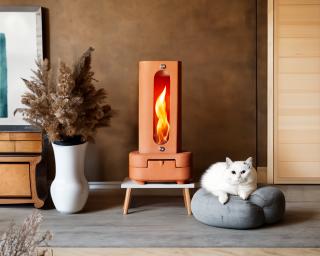
From warmth to fragrance, the Tornado Heater
Minimize fuel consumption, prioritize user safetyItalian design brand Egloo has created a chimney-shaped heater powered by bioethanol. Made of heat-resistant terracotta, the Tornado heater is named after the spinning shape of the flame visible through the opening on the front. In addition to being fun to look at in the form of a chimney, it aims to help reduce energy consumption by generating heat from natural and cost-effective bioethanol. "The Tornado is a unique and groundbreaking product that combines contemporary design with the timeless appeal of fire, resulting in a beautiful synergy of form and function," said Egloo. Inside the heater, the natural heat rise of the fire works synergistically with the terracotta structure to accelerate and rotate the air, an effect that increases heat flow by 500% without requiring additional energy. Tornado is also efficient, using the natural fuel bioethanol to minimize fuel consumption and eliminate the need for costly infrastructure or maintenance, which can significantly reduce heating costs. The benefits don't end there. The ceramic wool inside the tank increases Tornado's efficiency while also prioritizing user safety. Known for its high-temperature resilience and insulating capabilities, the material acts as a protective barrier to prevent potential fuel leaks and ensure that bioethanol is consumed in a controlled manner. The presence of this material ensures that the flame is stable and contained, minimizing the risk of explosion. Tornado can also be used as an essential oil diffuser. It's handmade in Italy and comes in six colors: orange-brown, white, black, beige, blue, and red, which are characteristic of terracotta. Link to original article: https://eglooinfo.it/product/egloo-tornado/?v=38dd815e66db
2023-11-28112 -
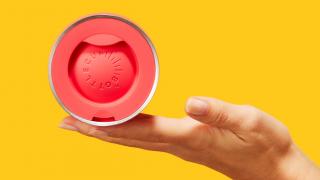
Reusable 2-in-1 water bottle and coffee cup
All components use recyclable materialsLondon studio Seymourpowell has combined an insulated water bottle and a cup with a lid into one in Bottlecup. Bottlecup's Kate and Mark Arnell realized that around 2.5 billion single-use coffee cups are used and thrown away in the UK every year, and only 1 in 400 of them are recycled, so they asked Seymourpowell to create a single item that could replace both disposable water bottles and coffee cups. Recognizing that while reusable cups are available, people often forget to carry containers with them, the project team found a way to combine a vacuum insulated bottle with a cup with a lid that can be used for to-go beverages.The team realized that existing reusable bottles or flasks on the market either do not provide a cup lid or the bottle and cup cannot be used independently of each other. "Bottlecup was innovated to combine a reusable water bottle and a reusable cup and cup lid into one seamless item, with both items functioning as independently of each other as possible without compromise," the designers explain. The stainless steel water bottle fits inside the cup and can be twisted into place when carrying both items. Each element features a gently curved silhouette that enhances ergonomics. The cup can be easily removed and used on its own, or it has a built-in silicone lid at the bottom so you don't have to carry a separate cup for smoothies, beer, soups, and other beverages. With multiple color options for the silicone band and cup lid, you can customize your Bottlecup by choosing your favorite color at the time of purchase. Sustainable design was a key concern throughout the project, and the use of no mixed materials resulted in a product where all components are easily recyclable. The 18/8 stainless steel used in the bottle and cup can be collected through curbside recycling services, while the band and cup lid are made from food-grade silicone and can be returned to Bottlecup for responsible recycling. Link to original article: https://www.dezeen.com/2023/11/26/seymourpowell-reusable-water-bottle-coffee-cup-bottlecup/ Originally published by Dezeen.
2023-11-28126 -
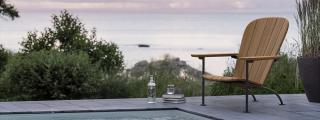
Long-lasting comfort, the Böste lounge chair
Durable stainless steel and teak constructionDesigner Stefan Borselius of Swedish furniture company Skargaarden has created a lounge chair that will stand the test of time. Named after the designer's hometown in southern Sweden, the Lounge Chair pays homage to the classic Westport chair with a Scandinavian twist. The angle at which the chair's back and seat meet encourages the user to relax and adopt a gentle reclining position that's perfect for socializing. The wide armrests double as a small side table, where you can place wine glasses, bowls, books, etc. There's also a separate footrest so users can lie down completely when they want. The chair is made of powder-coated stainless steel and sustainably sourced FSC-certified teak, which turns a silvery gray color over time, and the material is durable enough to withstand outdoor use in all seasons. "The Böste lounge chair can be placed on a soft beach, hard rock, grass, poolside or on a luxurious rooftop terrace," says Skargarden. Link to original article: www.dezeen.com/2023/02/21/boste-lounge-chair-stefan-borselius-skargaarden-dezeen-showroom/
2023-11-20100 -
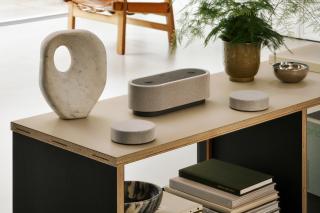
Portable home theater speakers from Sony
Experience true movie sound anywhereSony s HT-AX7 is a Bluetooth speaker system that makes it easy for users to enjoy surround sound wherever they want. The battery-powered wireless system consists of a base unit that acts as a soundbar and two smaller portable speakers that can be placed around the listener to immerse them in the sound. When you turn on the product's sound field mode, Sony's 360 spatial sound mapping technology reacts to the speaker position to create the effect of numerous phantom speakers surrounding you. This feature transforms stereo audio into a more immersive experience. "People today are demanding more technology than ever before and we are consuming content on portable devices in more diverse environments. Our new speaker system is a response to this, enabling people to experience true cinematic sound wherever they are," said Janhvi Sehgal, Sony Product Specialist. The disk-shaped satellite speaker is magnetically connected to the base to charge when not in use. All elements of the speaker are wrapped in a gray fabric, which incorporates fabric made from recycled plastic and PET bottles, specially developed with ecological impact in mind. The base unit features a soft gray silicone upper. The HT-AX7's packaging is also made from Sony s original blend of materials derived from bamboo, sugarcane and recycled paper. The speaker system is primarily designed to consume video content on devices such as laptops, tablets and smartphones, but users can also spread the speakers throughout a space to listen to music and other audio content. Link to original article: www.dezeen.com/2023/09/14/sony-ht-ax7-portable-home-theatre-speaker-system-video/
2023-11-2089 -
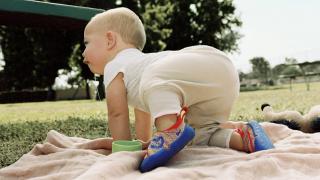
Nike introduces swoosh flyknit sneakers for babies and toddlers
Barefoot-like comfort and natural gaitSportswear brand Nike has launched the Nike Swoosh 1 sneaker, a flyknit shoe for babies and toddlers made from 80% recycled materials and designed to feel like you’re walking around barefoot. The shoe, which is available globally, is built to support early walkers, Nike says. "Promoting natural gait development is critical for early walkers. Research shows that our lifelong gait patterns begin to solidify as early as five to six months after we learn to walk. Our feet naturally need to bend, grasp, and extend to develop as intended," says Nike. The Nike Swoosh 1 features the brand's seamless flyknit upper for support for smaller feet and a thermoplastic polyurethane (TPU) outsole for grip and durability when walking. Made from 80% recycled materials, the colorful design features a deep blue outsole and an upper that's colorful in blue, yellow, and red. Bright red is also used as an accent color, while the brand's signature swoosh logo is presented in a childlike oversized style in a blue hue to match the sole. Also available in black and white, the shoe closes with a practical Velcro tab. The seamless knitted upper means that the Nike Swoosh 1 is very flexible, making it perfect for younger children, Nike says. Designed for children aged 9 to 36 months, the trainer has a wider toe box to allow the toes to naturally splay and flex. Link to original article: dezeen.com/2023/11/01/nike-swoosh-1-flyknit-trainers-babies-toddlers/ Originally published by Dezeen.
2023-11-1993 -
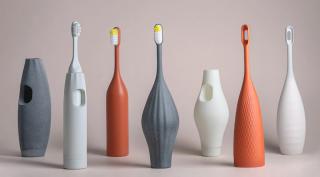
Custom 3D printed handle toothbrush
Customized toothbrushes for people with limited hand dexterityCreated by brand consulting firm Landor&Fitch for people with hand dexterity issues, this adaptive toothbrush includes more than 142 different handle designs. The textured grip accessory handles with chunky grips, grips that bulge outward like a tennis ball wrapped around, lattices, ridges, and other textures are custom-made and 3D printed for each customer based on an online questionnaire. They are also designed to attach to the handle of a regular toothbrush or electric toothbrush to create a larger grip. Refusing to be ordinary, the toothbrush is reminiscent of a sculpture in its shape, texture, and color, which makes it a great decorative object. According to Landor&Fitch, there are an estimated 360 million people around the world who live with problems using their hands, and Jack Holloway, head of industrial design at Landor&Fitch, told Dezeen: "While researching accessible design, we came across users who were using toothbrushes in a functional but very uncomfortable way - using dog toys, lollipop sticks and damp cloths to attach the toothbrush to their hands via an elastic band, which we realized as a creative team we could solve." To develop the product, Landor&Fitch brought together people with hand movement issues due to conditions such as arthritis, carpal tunnel syndrome and essential tremor. They invited them to co-design the product in a series of maker labs, hands-on workshops where participants could create shapes, test prototypes and share their experiences. Participants were involved in the entire process, testing and providing feedback on the final prototype, resulting in a toothbrush with 3D-printed handles that adapt to the movements of people with hand issues.
2023-11-19128 -
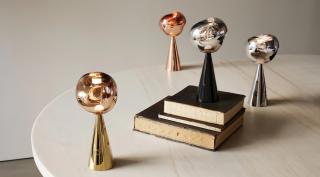
Tom Dixon s Portable Lamp for flexible lighting
Powerful batteries and low-energy light sourcesDesigner Tom Dixon s eponymous homeware brand has created portable lamps that run off of rechargeable batteries for three of its most popular lamps. The tantalizingly named Melt, Bell, and Stone designs are cordless. Shortlisted in the Lighting Design category > Finalist, they are designed to make living spaces more flexible. They combine battery power and low-energy LEDs to deliver nine hours of battery life per full charge. "We increasingly want our lighting to move with us because we no longer want to be tied to a fixed desk or power outlet," said Dixon, who founded the London-based brand in 2002. "Fortunately, the magic of technology has been realized with the combination of powerful batteries and low-energy light sources that allow us to shine light anywhere with complete adaptability," Dixon added. All of the portables have three dimmable settings for even more versatility and can be used indoors or outdoors. Among them, the Melt Portables were first unveiled in 2015 in collaboration with Swedish design studio Front and feature one of the brand's most unique designs. The fluidly shaped, seemingly air-blown glass table lamp is available in gold, silver, copper, or black metallic finishes. The Bell Portable is also made of pressed steel, and this design, first released in 2013, features a curved mirror surface. Finally, Stone Portable is the latest addition to the collection of lamps and accessories made from white Morwad marble. Tom Dixon first showcased the portables at the brand's Salone del Mobile exhibition during Milan Design Week in April, before officially launching them in August. Unlike the brand s previous Milan shows, the showcase focused on expanding the functionality and flexibility of existing products rather than launching new designs. Link to original article: https://www.dezeen.com/2023/11/17/tom-dixon-portable-lamps/
2023-11-18112 -
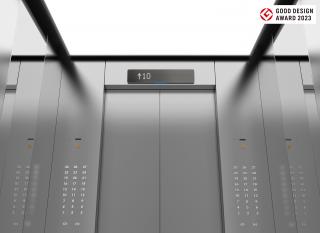
Hyundai Elevator wins Japan s Good Design Award, one of the world s top four design competitions
Air sanitation and cleaning combinedHyundai Elevator has won the Main Prize at the Good Design Award 2023, one of the world's top four design competitions. Launched in November 2022, the Air Sterilizer-Disinfector (PI-DD) combines air sterilization and cleaning functions in the floor indicator inside the elevator, with a perforated hole design that allows passengers and managers to naturally recognize the operating status without removing the display. In addition, the air inlet and outlet are located at the top to enhance aesthetics, and a magnetic cover is applied for easy maintenance. Hyundai Elevator Design Lab Manager Haknam Yoon, who designed PI-DD, said, "The idea was based on the increased awareness of the need for air purification and sterilization in elevators used by an unspecified number of people due to COVID-19." "Previously, the method of installing a separate sterilizer was used, but PI-DD incorporates it into the floor indicator to improve space efficiency and aesthetics." The judges noted that air purifiers and sterilizers are in high demand, but existing attachable products detract from the elevator's interior design, and the PI-DD was praised for its ease of management without detracting from the overall design. Organized by the Japan Institute of Design Promotion since 1957, the Good Design Award is a competition that comprehensively evaluates the design, usability, and innovation of a wide range of products, from general consumer goods to systems, services, and architecture. It is considered one of the world s four major design awards, along with Germany s Red Dot and iF Design Awards, and IDEA in the United States. With this award, Hyundai Elevator has won all four of the four major awards in the world. Website: http://www.hyundaielevator.co.kr Link to original article: https://www.newswire.co.kr/newsRead.php?no=976882
2023-10-3196







